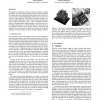Free Online Productivity Tools
i2Speak
i2Symbol
i2OCR
iTex2Img
iWeb2Print
iWeb2Shot
i2Type
iPdf2Split
iPdf2Merge
i2Bopomofo
i2Arabic
i2Style
i2Image
i2PDF
iLatex2Rtf
Sci2ools
123
Voted
HAPTICS
2011
IEEE
2011
IEEE
Weak spatial constancy in touch
We propose extending the concept of spatial constancy to haptic perception. In vision, spatial constancy refers to the conversion of retinotopic signals into spatiotopic representations, allowing the observer to perceive space independently of his or her own eye movements, or at least partly so. The problem would seem at least as important in haptic perception, where sensory surfaces undergo even more complex movements in space. Here we develop a methodology for studying haptic spatial constancy, which involves a tactile display mounted on a mobile platform, and which allows us to decouple movements of the sensory surface—in this case the fingertip—from movements of objects on the fingertip. Using this apparatus, we find evidence for only weak haptic spatial constancy.
Haptic Perception | Haptic Spatial Constancy | HAPTICS 2011 | Human Computer Interaction | Spatial Constancy |
| Added | 20 Aug 2011 |
| Updated | 20 Aug 2011 |
| Type | Journal |
| Year | 2011 |
| Where | HAPTICS |
| Authors | Mark Wexler, Vincent Hayward |
Comments (0)

